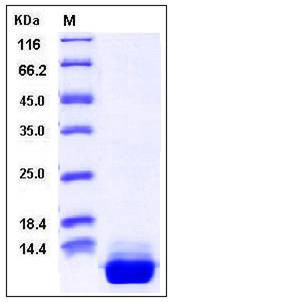Human S100A10 Protein (His Tag)
42C,ANX2L,ANX2LG,CAL1L,Ca[1],CLP11,GP11,MGC111133,p10,P11
- 100ug (NPP4229) Please inquiry
| Catalog Number | P11144-H07E |
|---|---|
| Organism Species | Human |
| Host | E. coli |
| Synonyms | 42C,ANX2L,ANX2LG,CAL1L,Ca[1],CLP11,GP11,MGC111133,p10,P11 |
| Molecular Weight | The recombinant human S100A10 consisting of 107 amino acids and migrates as an approximately 12.6 kDa band in SDS-PAGE under reducing conditions as predicted. |
| predicted N | Met |
| SDS-PAGE |  |
| Purity | > 95 % as determined by SDS-PAGE |
| Protein Construction | A DNA sequence encoding the human S100A10 (NP_002957.1) (Pro 2-Lys 97) was expressed, with a polyhistidine tag at the N-terminus. |
| Bio-activity | |
| Research Area | Cancer |Signal transduction |Signaling Pathway |Calcium Signaling |Calcium Binding Protein |S100 Protein | |
| Formulation | Lyophilized from sterile 20mM Tris, pH 8.5, 10% glycerol 1. Normally 5 % - 8 % trehalose, mannitol and 0.01% Tween80 are added as protectants before lyophilization. Specific concentrations are included in the hardcopy of COA. |
| Background | S100 protein is a family of low molecular weight protein found in vertebrates characterized by two EF-hand calcium-binding motifs. There are at least 21 different S100 proteins, and the name is derived from the fact that the protein is 100% soluble in ammonium sulfate at neutral pH. Most S100 proteins are disulfide-linked homodimer, and is normally present in cells derived from the neural crest, chondrocytes, macrophages, dendritic cells, etc. S100 proteins have been implicated in a variety of intracellular and extracellular functions. They are involved in regulation of protein phosphorylation, transcription factors, the dynamics of cytoskeleton constituents, enzyme activities, cell growth and differentiation, and the inflammatory response. Protein S100-A10, also known as Calpactin I light chain, Cellular ligand of annexin II, S100 calcium-binding protein A10, p10 protein, p11, ANX2LG and S100A10, is a member of the S100 family of small, dimeric EF hand-type Ca(2+)-binding proteins that generally modulate cellular target proteins in response to intracellular Ca(2+) signals. In contrast to all other S100 proteins, S100A10 is Ca(2+) insensitive because of amino acid replacements in its Ca(2+)-binding loops that lock the protein in a permanently active state. S100A10 forms a heterotetramer with annexin IIH and promotes carcinoma invasion and metastasis by plasminogen activation. S100A10 and annexin II contribute to the aggressive characteristics of anaplastic carcinoma, while playing a constitutive role in papillary carcinoma. S100A10 induces the dimerization of ANXA2 / p36, it may function as a regulator of protein phosphorylation in that the ANXA2 monomer is the preferred target of tyrosine-specific kinase. S100A10 functions as a linker tethering certain transmembrane proteins to annexin A2 thereby assisting their traffic to the plasma membrane and/or their firm anchorage at certain membrane sites. |
| Reference |
